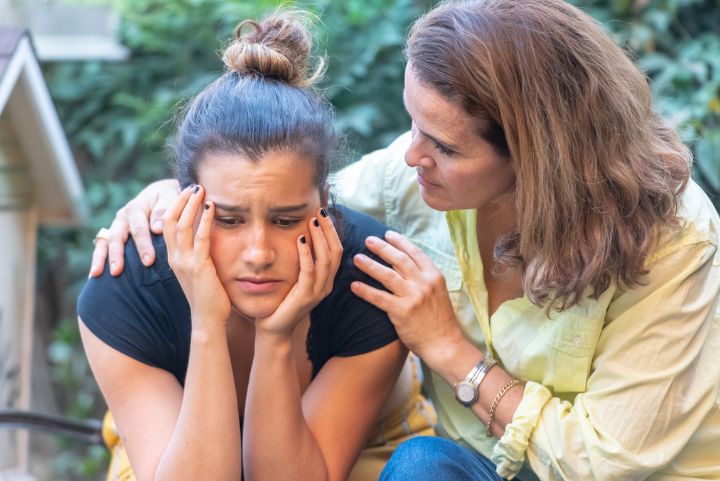Anxiety can be difficult to distinguish from other conditions, with overlaps in both cognitive processing and physiological responses. If you understand anxiety and other health conditions, you can better identify what’s going on and seek proper treatment.
Overview of Anxiety
Most people experience anxiety from time to time. A significant number are also diagnosed with an anxiety disorder, including an estimated 31.9% of teenagers in the United States. Feelings of nervousness, fear, or stress become disordered if:
- They are constant, overwhelming, or out of control
- They are disproportionate to the situation
- They interfere with everyday activities like school, work, or daily routines
The American Psychiatric Association identifies several types of anxiety disorders, each with its own diagnostic criteria and symptoms. Teens may experience generalized anxiety disorder, social anxiety disorder, or other anxiety disorders. Not all anxiety presents the same, but common symptoms include:
- Difficulty concentrating
- Difficulty falling asleep or staying asleep
- Feeling irritable or on edge
- Feeling panic, fear, dread, and uneasiness
- Heart palpitations
- Restlessness
- Shortness of breath
- Uncontrollable thoughts
These symptoms may be present because of other conditions, or anxiety may be a comorbid condition, meaning that anxiety and other conditions exist simultaneously. Only a qualified clinician can diagnose anxiety or rule out other conditions as the cause of symptoms.
Anxiety vs Stress
Anxiety and stress are both common reactions to strong stimuli as part of the body’s fight-or-flight response. A short-term threat response, stress causes the body to release hormones that increase heart rate, breathing, and blood pressure. In healthy doses, it makes people more alert and ready to tackle problems.
Anxiety can produce the same physiological responses as stress but usually lingers over a longer period. Unlike stress, which is a response to a recognized threat, the cause of anxiety may be less defined or even entirely unidentifiable. Feelings of dread and anxious thoughts accompany the physical response. Over time, uncontrolled stress responses may lead to anxiety.
Anxiety vs Stress Symptoms
| Symptom | Anxiety | Stress | Notes |
| Short Term | ✓ | Stress is focused on short-term threats, while anxiety persists over time, even when threats are not actively present. | |
| Racing Heart | ✓ | ✓ | |
| Increased Breathing | ✓ | ✓ | |
| Feelings of Fear or Dread | ✓ | ||
| Restlessness | ✓ | Stress is conducive to action, while anxiety may cause restlessness. |
Anxiety vs ADHD
Attention deficit hyperactivity disorder (ADHD) is a neurodevelopmental disorder. Most often diagnosed in childhood, this disorder is characterized by symptoms of inattention, hyperactivity, and impulsivity. Attention deficit disorder (ADD) was once a diagnostic term used to describe a predominantly inattentive presentation of the disorder.
Anxiety vs ADD/ADHD can be difficult for some individuals to determine, as many symptoms overlap. They can both cause problems with focus or feelings of restlessness. Many individuals may have both anxiety and ADHD. Up to 30% of children with ADHD may also have an anxiety disorder. While anxiety symptoms come with fear and dread, ADHD symptoms persist even in times of calm.
Anxiety vs ADHD Symptoms
| Symptom | Anxiety | ADHD | Notes |
| Trouble Focusing | ✓ | ✓ | |
| Restlessness | ✓ | ✓ | |
| Feelings of Fear or Dread | ✓ | ||
| Uncontrolled Worry | ✓ | ||
| Racing Heart | ✓ | Present in anxiety, but a slightly elevated heartbeat may sometimes occur with ADHD. | |
| Fidgeting | ✓ | Present in ADHD, but may occasionally present as a coping mechanism in anxiety. |
Anxiety vs Depression
Depression and anxiety are both mood disorders. Symptoms of depression include feelings of sadness, irritability, or hopelessness. People experiencing depression often lose interest in pleasure in previously enjoyed activities. Similar to anxiety, depression may cause sleep problems, fatigue, and difficulty focusing.
As some of the most common mental health diagnoses, depression and anxiety often present as comorbid conditions. Around 60% of people with depression also experience anxiety and vice versa. A key difference between the two conditions is their physiological manifestation. While anxiety may cause low energy and focus, it also comes with rapid heartbeat, muscle tension, and sweating. Depression typically does not activate these types of bodily responses.
Anxiety vs Depression Symptoms
| Symptom | Anxiety | Depression | Notes |
| Sleep Problems | ✓ | ✓ | |
| Fatigue | ✓ | ✓ | |
| Trouble Focusing | ✓ | ✓ | |
| Irritability | ✓ | ✓ | |
| Feelings of Sadness or Hopelessness | ✓ | ||
| Feelings of Fear or Dread | ✓ | ||
| Racing Heart | ✓ | ||
| Muscle Tension | ✓ |
Anxiety vs OCD
Obsessive-compulsive disorder (OCD) is a mental health condition that causes obsessions, compulsions, or both. Obsessions are persistent, often unwanted, thoughts that cause distress. Compulsions are repetitive behaviors in response to obsessive thoughts. In individuals with OCD, these obsessions and compulsions become disruptive to functioning and may cause feelings of anxiety.
OCD was once categorized as an anxiety disorder and has many similar symptoms. Both may cause an individual to feel restless, irritable, or distressed. However, generalized anxiety does not come with the same pattern of obsessions and compelled compulsions. The distress from OCD tends to be more specific and may increase in intensity if one is unable to follow through with their compulsions.
Anxiety vs OCD Symptoms
| Symptom | Anxiety | OCD | Notes |
| Restlessness | ✓ | ✓ | |
| Irritability | ✓ | ✓ | |
| Feelings of Fear or Dread | ✓ | ✓ | With OCD, it may stem from disrupted compulsions. |
| Obsessive Thoughts | ✓ | While anxiety might cause rumination in some, obsessive thought patterns are more defined in OCD. | |
| Compulsive Behaviors | ✓ | This is typically not present in generalized anxiety. | |
| Specific Focus | ✓ | OCD tends to have a specific focus, while anxiety is more broad. |
Anxiety vs Autism
Autism spectrum disorder is a developmental disability. Symptoms have a wide spectrum of presentations, but many people experience developmental delays and engage in divergent behaviors.
In some individuals, the symptoms have a significant overlap with anxiety. Anxiety and autism also frequently co-occur, with anxiety more likely to present in autistic people than in other populations. Autistic people often experience symptoms of social anxiety and separation anxiety and rely on routines to keep their nervous system balanced.
Autism usually has more symptoms than just anxiety, including communication differences and difficulty transitioning to new environments.
Anxiety vs Autism Characteristics
| Characteristic | Anxiety | Autism | Notes |
| Communication Differences | ✓ | These may be part of developmental and neurodivergent differences in autism. | |
| Difficulty Transitioning | ✓ | This may be part of developmental and neurodivergent differences in autism. | |
| Feelings of Fear or Dread | ✓ | ✓ | This is often related to specific communication or social anxieties in autism. |
| Fear of Judgement in Social Situations | ✓ | ✓ | It’s present in social anxiety and autism. |
| Fear of Separation from Specific People | ✓ | ✓ | It’s present in separation anxiety and autism. |
Anxiety vs Fear
Though the two terms may be used interchangeably in casual contexts, clinicians offer a distinction between anxiety and fear. One study framed it this way: Fear is the response to an active or imminent threat, while anxiety is a state of anticipation waiting for a future threat (even if the threat is unlikely).
Both states cause similar feelings of activation and worry. Fear happens in the present moment, while anxiety anticipates future discomfort or scenarios. Both may cause physical symptoms like a racing heart or shortness of breath.
Anxiety vs Fear Symptoms
| Symptom | Anxiety | Fear | Notes |
| Feelings of Fear or Dread | ✓ | ✓ | |
| Racing Heart | ✓ | ✓ | |
| Breathing Difficulties | ✓ | ✓ | |
| Response to Present, Active Threat | ✓ | ||
| Response to Future, Possible Threat | ✓ |
Anxiety Attack vs Panic Attack
Some people refer to instances of anxiety as anxiety attacks, though this isn’t a clinical term. Panic attack is a clinical term that refers to an instance of sudden-onset and overwhelming fear.
Panic disorder, in which a person experiences recurring panic attacks, is one type of anxiety disorder. It commonly occurs with other anxiety disorders, with overlapping symptoms.
Panic attacks differ from generalized anxiety in their intensity and duration. A panic attack typically lasts for several minutes; intense physical symptoms like a racing heartbeat, shortness of breath, chest pain, and dizziness or nausea accompany fearful feelings. Drowsiness and fatigue often follow panic attacks, while periods of anxiety can be more diffused and sustained.
Anxiety Attack vs Panic Attack Symptoms
| Symptom | Anxiety | Panic Attack | Notes |
| Feelings of Fear or Dread | ✓ | ✓ | This is more intense in panic attacks. |
| Sudden Onset | ✓ | Panic attacks typically occur suddenly and without warning. | |
| Short Time Frame | ✓ | Panic attacks last for several minutes, while anxiety persists for longer. | |
| Racing Heart | ✓ | ✓ | This is more intense in panic attacks. |
| Breathing Difficulties | ✓ | ✓ | This is more intense in panic attacks. |
| Specific Trigger | ✓ | Anxiety is often tied to specific triggers, while panic attacks may have no obvious cause. |
Anxiety vs Paranoia
Paranoia causes delusional thoughts about persecution. People experiencing paranoia mistrust others, thinking that they will be harassed, betrayed, or disbelieved. Paranoia can be caused by dementia, drug use, or certain mental health conditions such as schizophrenia.
Both paranoia and anxiety can cause physical responses like a racing heart. Paranoia can cause significant fear or anxiety. However, the two conditions are fueled by distinctly different thought patterns.
Anxiety vs Paranoia Symptoms
| Symptom | Anxiety | Paranoia | Notes |
| Racing Heart | ✓ | ✓ | |
| Feelings of Fear or Dread | ✓ | ✓ | Paranoia may cause feelings of anxiety. |
| Thoughts of Persecution | ✓ | ||
| Mistrust of Others | ✓ |
Anxiety vs Nervousness
Nervousness is a common reaction to a stressor, like a new or important situation. The first day of school, a big presentation, or a long-anticipated social gathering can make someone nervous. The feeling may prompt a racing heart, difficulties breathing, or sweating hands, but symptoms resolve after the situation passes.
Nervousness and anxiety have physical symptoms in common, but they differ in intensity, duration, and focus. Unlike the relatively quick-passing symptoms of nervousness, anxiety persists over time and isn’t always focused on a specific trigger or event. Feelings of anxiety often lead to avoidance of similar situations in the future, while nervousness typically does not.
Anxiety vs Nervousness Symptoms
| Symptom | Anxiety | Nervousness | Notes |
| Racing Heart | ✓ | ✓ | |
| Breathing Difficulties | ✓ | ✓ | |
| Specific Trigger | ✓ | ||
| Leads to Avoidance | ✓ |
Anxiety vs PTSD
Post-traumatic stress disorder (PTSD) is a mental health condition that may occur in individuals after they experience a traumatic event. Symptoms include feelings of anxiety, intrusive memories or nightmares about the traumatic event, and feelings of isolation from others.
PTSD and anxiety commonly co-occur. In one study of flood survivors (an example of an event with a high chance of triggering PTSD), 64.52% of those with PTSD also had anxiety. A key distinction between the two conditions is their root cause. Anxiety may stem from stress or medical or psychological conditions. PTSD occurs after specific, traumatic events—though the type of events that cause trauma can be wide-ranging.
Anxiety vs PTSD Symptoms
| Symptom | Anxiety | PTSD | Notes |
| Feelings of Fear or Dread | ✓ | ✓ | |
| Racing Heart | ✓ | ✓ | |
| Breathing Difficulties | ✓ | ✓ | |
| Onset After Traumatic Event | ✓ | Anxiety can happen at any time. PTSD only happens after a traumatic event. | |
| Nightmares or Flashbacks About Traumatic Events | ✓ | Anxiety may include nightmares or intrusive thoughts, but they are not focused on a specific traumatic event. |
Anxiety Treatment with Muir Wood
Muir Wood provides residential treatment for teens with anxiety and other mental health and substance-related conditions. As part of our intake process, we perform comprehensive evaluations to identify and diagnose a teen. This allows us to provide informed and targeted treatment, designed for each individual’s unique needs.
Whether your teen has anxiety or needs support for another behavioral health issue, we can help. Contact us today to get started.









